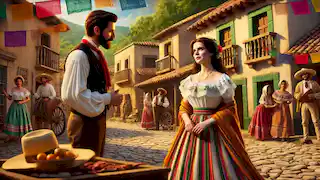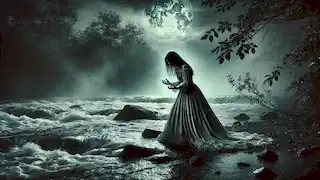In the heart of Mexico, where the ancient roots of indigenous civilizations still pulse through the soil, there exists a tale that has haunted generations for centuries. It is the legend of La Llorona—the Weeping Woman. Her story, one of sorrow and woe, has been passed down from one generation to the next, whispered in the darkness to warn children and adults alike of the lurking specter near the rivers and lakes. The tragic figure of La Llorona stands as a symbol of love, betrayal, and eternal suffering, a ghost whose cries echo through the night, a mother searching for her lost children in vain. The story of La Llorona begins long ago, during the colonial period of Mexico, when indigenous people and Spanish settlers lived in uneasy proximity. At the heart of this tale was a woman named Maria. Born in a humble village, Maria was renowned for her beauty. Her dark hair, flowing like the waters of the river, and her striking eyes captivated everyone who laid eyes upon her. She was considered the jewel of her town, and many men sought her hand in marriage. But Maria had ambitions that extended beyond the boundaries of her small village. One day, a wealthy Spanish nobleman came to Maria's village. With his fine clothing, gallant demeanor, and promises of a better life, he quickly won Maria’s heart. They fell in love, or at least Maria believed they had, and soon after, they were married. The union was joyous at first, and Maria bore the nobleman two beautiful children. However, as time passed, the nobleman's interest in Maria waned. He began to travel more frequently, visiting nearby cities, leaving Maria and the children behind in the village. The once passionate love between Maria and the nobleman cooled. He became distant, and rumors began to spread that he had taken a lover in the city—a Spanish woman of his own class. Maria's heart filled with anger and sorrow. She had sacrificed everything for the nobleman, leaving behind her humble roots and her family, only to be discarded. One day, the nobleman returned to the village, not to visit Maria or their children, but to introduce his new fiancée. This woman, adorned in fine silk and jewels, was everything Maria was not: a member of the Spanish elite, privileged, and secure in her position. The nobleman treated Maria as if she were nothing more than a distant memory, and worse, he showed no affection for their children. Maria was devastated. Blinded by rage and jealousy, she felt as though her entire world had been shattered. How could the man she had given everything to betray her so callously? It was then that something within Maria snapped. One dark evening, in the throes of despair, Maria took her two children to the nearby river, the same river where she and the nobleman had once shared joyful moments together. The sound of rushing water filled the air, and as she stood by the riverbank, something primal and uncontrollable surged within her. Maria, consumed by grief and a need for vengeance, did the unthinkable. In one horrifying moment, Maria pushed her children into the river's swift current. Their cries were drowned by the water as they disappeared into the depths. Almost immediately, the weight of her actions crashed upon Maria like the very water that had swallowed her children. She screamed and wailed, running along the riverbank in a futile attempt to save them, but it was too late. The river had claimed them. Grief-stricken and horrified by what she had done, Maria wandered the banks of the river, calling out for her children, her heart shattered beyond repair. The villagers heard her cries that night, and when they found her, she was inconsolable. She wept and wept until her voice gave out, but no amount of tears could bring her children back. Overcome with guilt and unable to bear the pain, Maria threw herself into the river, where she too was consumed by the waters. However, death did not bring Maria the peace she so desperately sought. Instead, she became cursed to wander the earth for eternity, searching in vain for the children she had lost. Her spirit, now known as La Llorona, the Weeping Woman, haunts the rivers and lakes, crying out in sorrow and regret. Her wails are said to send chills down the spine of anyone who hears them, and her presence is an omen of misfortune. As the years passed, the story of La Llorona spread throughout Mexico and beyond. People living near rivers and lakes reported hearing her cries in the dead of night, a mournful wail that seemed to rise from the very water itself. "¡Ay, mis hijos!" she would cry. "Oh, my children!" Her voice, filled with grief and despair, would carry through the air, chilling those who heard it to their very core. Parents would tell their children to stay away from the water at night, warning them that La Llorona might mistake them for her lost children and drag them into the river to share her watery fate. Many believed that if you saw La Llorona, her presence would bring misfortune. Some even claimed that her ghost had the power to lure people to their deaths, just as she had been driven by madness to drown her own children. The legend varied depending on the region. In some versions of the story, La Llorona was said to wear a long, white dress, her hair flowing wildly around her face, while in others, she appeared as a shadowy figure, barely visible but always present near bodies of water. Yet, one thing remained consistent: her eternal sorrow. La Llorona’s cries, whether whispered on the wind or shouted in anguish, were a constant reminder of her torment and guilt. Over time, La Llorona became more than just a ghost story; she became a symbol of deep, human emotions—grief, guilt, and the consequences of betrayal. Her story resonated with those who had experienced loss or heartbreak, and she became a figure that people feared and pitied in equal measure. Many people have claimed to encounter La Llorona, particularly those who live near rivers or lakes. One of the most famous encounters took place in the early 1900s, when a family living near the banks of a river in Mexico City reported strange occurrences. At first, they heard soft crying at night, but when they went outside to investigate, they saw nothing. The cries continued for several nights, growing louder and more desperate each time. One evening, as the family was gathered around their hearth, they heard a blood-curdling scream that seemed to come from right outside their door. The father rushed outside with a lantern, but all he saw was the fog rolling in from the river. Suddenly, out of the mist, a figure appeared. It was a woman, dressed in a long, flowing white gown, her face obscured by her hair. She was weeping, her sobs echoing through the night. The man called out to her, but the figure did not respond. Instead, she moved slowly toward the riverbank, her cries growing softer as she neared the water. The man, unsure of what he had just witnessed, returned to his home, shaken. The next morning, the family found wet footprints leading from the river to their front door, as if someone—or something—had been standing there, watching them. Other stories tell of travelers who have seen La Llorona on lonely roads near rivers or lakes. They describe her as a woman in white, her face pale and gaunt, her eyes hollow from centuries of crying. Some claim that she has spoken to them, asking if they have seen her children, her voice filled with the sorrow of a mother who has lost everything. La Llorona remains a powerful figure in Mexican folklore, her story still told by parents to their children, especially in rural areas where the rivers run deep and the nights are quiet. Her legend has transcended borders, becoming known throughout Latin America and even parts of the United States, where Hispanic communities have brought the tale with them. In modern times, La Llorona has become a cultural icon, featured in films, books, and artwork. She has taken on new forms, sometimes portrayed as a vengeful spirit, other times as a tragic figure deserving of sympathy. Yet, at her core, La Llorona remains a symbol of a mother’s love gone terribly wrong and the eternal consequences of a single, horrific mistake. Many believe that La Llorona's story is a cautionary tale, warning of the dangers of uncontrolled emotions and the devastating impact they can have on those around us. It is a story of betrayal, loss, and remorse that speaks to the deepest parts of the human experience. And though centuries have passed since Maria first wept by the river, her cries continue to haunt the nights of those who dare to listen. The legend of La Llorona is a story that never truly ends. Her cries continue to be heard, and her ghost is said to roam the rivers, always searching, never finding peace. For many, the tale is more than just a ghost story; it is a reflection of the pain that we all carry within us, the grief that can never be undone, and the consequences of choices made in moments of despair. To this day, the rivers of Mexico flow with the memory of La Llor ona, and her story lives on, passed down through the generations, a haunting reminder of the fragility of the human soul.The Origins of La Llorona

The Tragic Night
The Haunting of La Llorona

Encounters with the Weeping Woman

The Lasting Legacy of La Llorona

Epilogue: The Echoes of the Weeping Woman
The Legend of La Llorona
Reading Time: 9 min

About Story: The Legend of La Llorona is a Legend Stories from mexico set in the 18th Century Stories. This Dramatic Stories tale explores themes of Loss Stories and is suitable for All Ages Stories. It offers Moral Stories insights. A haunting legend of love, loss, and eternal sorrow.

















